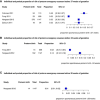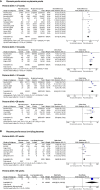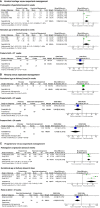Risk of preterm birth for placenta previa or low-lying placenta and possible preventive interventions: A systematic review and meta-analysis
- PMID: 36120450
- PMCID: PMC9478860
- DOI: 10.3389/fendo.2022.921220
Risk of preterm birth for placenta previa or low-lying placenta and possible preventive interventions: A systematic review and meta-analysis
Abstract
Objective: To investigate the risk of preterm birth in women with a placenta previa or a low-lying placenta for different cut-offs of gestational age and to evaluate preventive interventions.
Search and methods: MEDLINE, EMBASE, CENTRAL, Web of Science, WHO-ICTRP and clinicaltrials.gov were searched until December 2021. Randomized controlled trials, cohort studies and case-control studies assessing preterm birth in women with placenta previa or low-lying placenta with a placental edge within 2 cm of the internal os in the second or third trimester were eligible for inclusion. Pooled proportions and odds ratios for the risk of preterm birth before 37, 34, 32 and 28 weeks of gestation were calculated. Additionally, the results of the evaluation of preventive interventions for preterm birth in these women are described.
Results: In total, 34 studies were included, 24 reporting on preterm birth and 9 on preventive interventions. The pooled proportions were 46% (95% CI [39 - 53%]), 17% (95% CI [11 - 25%]), 10% (95% CI [7 - 13%]) and 2% (95% CI [1 - 3%]), regarding preterm birth <37, <34, <32 and <28 weeks in women with placenta previa. For low-lying placentas the risk of preterm birth was 30% (95% CI [19 - 43%]) and 1% (95% CI [0 - 6%]) before 37 and 34 weeks, respectively. Women with a placenta previa were more likely to have a preterm birth compared to women with a low-lying placenta or women without a placenta previa for all gestational ages. The studies about preventive interventions all showed potential prolongation of pregnancy with the use of intramuscular progesterone, intramuscular progesterone + cerclage or pessary.
Conclusions: Both women with a placenta previa and a low-lying placenta have an increased risk of preterm birth. This increased risk is consistent across all severities of preterm birth between 28-37 weeks of gestation. Women with placenta previa have a higher risk of preterm birth than women with a low-lying placenta have. Cervical cerclage, pessary and intramuscular progesterone all might have benefit for both women with placenta previa and low-lying placenta, but data in this population are lacking and inconsistent, so that solid conclusions about their effectiveness cannot be drawn.
Systematic review registration: PROSPERO https://www.crd.york.ac.uk/prospero/, identifier CRD42019123675.
Keywords: cerclage; low-lying placenta; pessary; placenta previa; preterm birth; preventive interventions; progesterone.
Copyright © 2022 Jansen, van Dijk, Kleinrouweler, Holzscherer, Smits, Limpens, Kazemier, van Leeuwen and Pajkrt.
Conflict of interest statement
The authors declare that the research was conducted in the absence of any commercial or financial relationships that could be construed as a potential conflict of interest.
Figures





References
Publication types
MeSH terms
Substances
LinkOut - more resources
Full Text Sources

